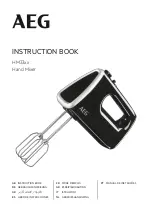
Memory Storage
Brightness, Colour, Beamshape and
Position memories are stored in
separate areas allowing up to 990
memories per attribute.
Brightness memories are stored in a
cue list which may be accessed in
sequence or in random fashion.
Colour, Beamshape and Position
memories are accessed via 99 pages
consisting of 10 directly accessible
memories per page.
Memory Types
There are several types of memory
described below.
Full Memory
A full memory records a value for an
attribute for all fixtures, even if the
fixture is inactive in that memory.
Outputting a full memory sets that
attribute for the whole rig.
Partial Memory
A partial memory only records values
for those parameters that have been
adjusted on the selected fixtures. The
only exceptions to this are Pan and Tilt,
which are both recorded if one is
adjusted.
Example:
Memory 1 is a full colour memory with
all three fixtures in red.
Memory 2 is a full colour memory with
all three fixtures in green.
Memory 3 is a partial colour memory
with fixture 2 in blue.
When Memory 1 is output, fixtures 1, 2
and 3 turn red.
If Memory 3 is then output, fixture 2
turns blue, and the others remain
unaffected, i.e. red.
If Memory 2 is then output, all fixtures
turn green.
If Memory 3 is then output, fixture 2
turns blue, and the others remain
unaffected, i.e. green.
Scene Memory
A scene memory contains channel
level information for a fixture or group
of fixtures, together with associated
fade times.
Brightness memories are always full
scene memories.
Colour, Beamshape and Position
memories can be either full or partial
scene memories.
Chase Memory
A chase memory contains multiple
steps of channel level data for a single
fixture or group of fixtures. Effectively
each step of a chase can be regarded
as a scene memory.
Brightness chase memories are always
full chase memories.
Colour, Beamshape and Position
memories can be either full or partial
chase memories.
Sound To Light
Four bands (steps) are programmed,
when replayed, the audio level out from
of each of the four sound filters (bass,
tenor, alto, treble) determines the
Audio memory output for each band.
Ripple Sound
Four bands are programmed when
replayed the volume of the audio input
determines how many of the bands are
output. With no volume Band one is
always output
NOTE
Memory Usage
Use a full memory at the beginning of a new
scene (or when a major change of state is
required).
Use partial memories to build on from there.
/p3-3/3
n
Figure 3-4: Attribute selection
buttons
3
Program Mode
7364000/p3-3/3
3 - 3
Summary of Contents for SIRIUS 250
Page 1: ...SIRIUS 500 250 OPERATOR S MANUAL...
Page 3: ...ii...
Page 7: ...Pvi V3 TABLE OF CONTENTS vi 7364000 Pvi V3...
Page 15: ......
Page 30: ...p3 11 3 7364000 p3 11 3 3 11...
Page 57: ......
Page 67: ...p4 10 1...
Page 107: ......
Page 111: ......
Page 117: ......
















































